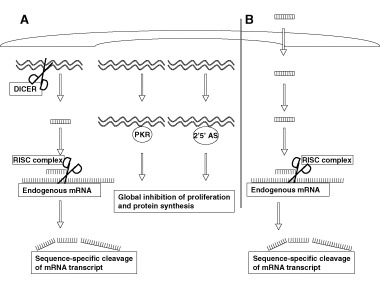Figure 1.

Induction of RNA interference. (A) Natural gene silencing by long double‐stranded RNA (dsRNA). Upon viral infection or the presence of other dsRNA transducted intracellularly, an innate defense system is activated that causes the sequential degradation of the dsRNA by the type III endonuclease DICER. This endonuclease subsequently cleaves the dsRNA into 21 nucleotide double‐stranded fragments. These fragments then associate with the RNA‐induced silencing complex (RISC) complex and induce cleavage of endogenous mRNA transcripts in a sequence‐ and length‐ specific manner. However, long dsRNA also activates 2′5 oligosynthetase which induces nonspecific interferon response and global shutdown of protein synthesis. (B) Artificial gene silencing through siRNA. To take advantage of the gene‐silencing effect while circumventing nonspecific cellular effects, synthetic dsRNA of 21 nucleotides are transfected into the cell. This small interfering RNA (siRNA) is not recognized by DICER or 2′5 oligosynthetase, but instead directly binds the RISC complex that subsequently induces selective silencing of endogenous transcripts.
